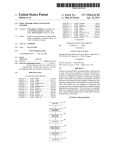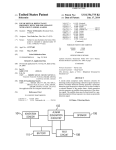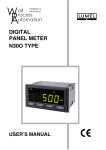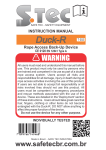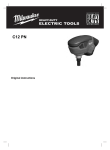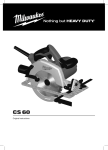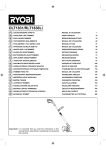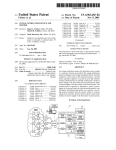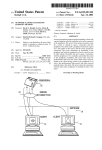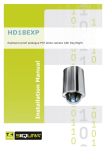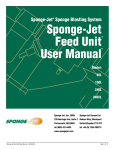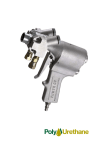Download Network peripheral server discovery method
Transcript
US006839755B1 (12) United States Patent (10) Patent N0.2 Kumpf et al. (54) NETWORK PERIPHERAL SERVER DISCOVERY METHOD (75) Inventors: GUIESHPDR‘ David A. Kumpf, ?ring’ - Rocklin, (ltr?ssp?léex CA (US); 5A1,A ( )> a“ ' ml ’ 6,101,528 A 6,101,555 A * * 6,131,120 A * 10/2000 Assignee: Hewlett-Packard Development Notice: 4/2001 ( (58) Kumpf et al. ...... .. 6,237,032 B1 * 5/2001 Scoville e161. 6,289,371 B1 * 9/2001 K 710/19 709/227 709/221 f t 1. ............ .. 709/203 ump e a * cited by examiner Appl NO _ 09/163 787 .. (22) Filed: 5 709/225 patent Subjectistoextended any disclaimer, or adjusted the term under of this 35 . (51) Reid .............. .. FOREIGN PATENT DOCUMENTS U.S.C. 154(b) by 868 days. (21) 8/2000 Butt ......................... .. 709/203 8/2000 Goshey et al. . 709/321 6,223,223 B1 * Company, L.P., Houston, TX (US) (*) Jan. 4, 2005 6,195,712 , , B1 *Z: 2/2001 Pawlowskietal. gllllgiurat en e 9; a. a1~......... .. 1 5 mg ’ (Us) (73) US 6,839,755 B1 (45) Date of Patent: Primary Examiner—Jason D. Cardone , Sep. 30, 1998 (57) ABSTRACT Int. c1.7 ...................... .. G06F 15/173; G06F 15/16 A mulnfuncnon PenPh‘?ra1.SeWer dlsc9very method Wlth U S C] reduced network trafflc is disclosed. Peripheral servers on a .- - 09 22 _ - . . . . . . . . . . . . . . . . . . . . . . . . . . . . . . . . . . . . . . .. 7 / 5, network advertise their basic function, Such as print, and Fleld 0f Search ............................... .. 709/203, 219, Clients Seeking peripherals With an additional function, Such 709/225> 217> 228> 226> 229; 358/1'15> 1'13; 710/3> 4> 15> 36> 42 as scan, retrieve ID strings of peripherals having the basic function to determine if the additional function is available. (56) References Cited The method also permits a user of a client on the network to enter addresses of peripherals not discovered when the client searches for peripherals having the additional function. The US PATENT DOCUMENTS 55487722 A : 8/1996 Jalahan et a1: ~~~~~~~~~~~~ " 709/220 2 * 5,774,662 A * 5,784,560 A * 5,928,335 ‘cxjiiigreettsll' 6/1998 is a determination of whether discovered peripherals having sakagawa ~ ~ ~ ~ ~ ~ ~ ~ ~ ~ N 709003 the additional function 'are 709/201 aPPhCamn run by the Chem 7/1998 Kingdon et al. Morita method also permits selection of a network protocol to be used by the client. An additional preferred step in the method A * 7/1999 5,933,580 A * 8/1999 Uda et al. ................ .. 358/1.13 . ... ... .. .. . . . .. compatible with 709/203 12 Claims, 10 Drawing Sheets SEARCH NETWORK F0 " SPECIFIC SERVERS 1| ETERMINE IF SERVER IS ATTACHED 0 PERIPHERAL THAT CAN SUPPORT OFI'WARE FOR USER TO RESPOND PROMPT USER TO ENTER NETWORK ADDRESS OF DESIRED SERVER CONTACT S RVER AND CHECK FOR OMPATIBLE PERH’I-IERAL AND SERVER FIRMWARE FEATURES COMPATIBL DEVICE? STORE PARAMETERS OF SELECTED SERVER IN PERSISTENT DATABASE SO THAT THEY ARE AVAILABLE TO CLIENT APPLICATION WHEN EXECUTED AT A LATER TIME C] a software U.S. Patent Jan. 4,2005 Sheet 1 0f 10 US 6,839,755 B1 PERIPHERAL 1O SERVER (JET DIRECT EX) NETWORK 14 CLIENT @ CLIENT A 12 SB 12 / ::Q\ —\ ' FIG. 1 1 U.S. Patent Jan. 4,2005 Sheet 3 0f 10 US 6,839,755 B1 ‘ SEARCH NETWORK F0 SPECIFIC SERVERS DETERMINE IF SERVER IS ATTACHED TO PERIPHERAL THAT CAN SUPPORT SOFTWARE I ‘ 20 REMOVE SERVERS WITH NON-COMPATIBLE FIRMWARE YES NO 24 DISPLAY LIST OF PROMPT USER TO ENTER lq PERIPHERALS AND WAIT FOR USER TO RESPOND USER SELECTED A PERIPHERAL l7 f 3,2 NETlgvg’gllllaléglgggsEg 0F Y CONTACT SERVER AND 34 CHECK FOR COMPATIBLE k“ PERIPHERAL AND SERVER FIRMWARE FEATURES T STORE PARAMETERS 0F SELECTED SERVER YES IN PERSISTENT DATABASE SO THAT THEY ARE AVAILABLE TO CLIENT APPLICATION FA 30 WHEN EXECUTED AT A LATER TIME r‘ DONE I FIG. 3 U.S. Patent Jan. 4,2005 Sheet 4 0f 10 US 6,839,755 B1 526A522v “w2%W0xE:@E2gza03mIS52zw8 mm?92.EEO5ME55%é2m5z2 05% w .QE U.S. Patent Jan. 4,2005 Sheet 10 0f 10 US 6,839,755 B1 .... -..m 525 6% I4I .2;2E$s9m85w71o2g8m 05% GE w US 6,839,755 B1 1 2 NETWORK PERIPHERAL SERVER DISCOVERY METHOD the network. For example, traditional servers send a separate SAP for each socket being advertised, i.e., for each print BACKGROUND OF THE INVENTION socket and each scan socket. Thus, under the traditional scheme, a three port server would generate six SAPs since the server would send a separate SAP advertisement for each The present invention generally relates to software, and more particularly to software for discovering peripheral print and scan socket. Likewise, a one port server would generate two SAPs on a regular basis. Another problem with known discovery software is its server devices on a network. Computer network servers are an integral segment of the in?exibility. Typically, discovery software only allows the computer industry. Networks establish connections with at 10 user to select from a group of discovered servers. There are least one server which in turn initiate connections with one times, however, that the user may wish to enter a known or more peripherals. Such peripherals perform many server address. Additionally, there are times that a user must functions, including scanning. Some peripherals, namely enter a server address because the discovery software failed multifunction peripherals, combine scanning with various other functions such as printing, sending and receiving to ?nd any servers. Accordingly, it is a primary object of the present invention to provide an improved method for discovering network facsimiles and copying. When a user wishes to perform a which servers, if any, can establish a connection with a peripheral servers. Another object of the present invention is to provide an peripheral containing the required scan capabilities. improved method for reducing SAP traf?c. function, for example, a scan, it is important to determine Known methods to determine available network servers include the user physically locating the server, using a name lookup service to ascertain the server’s name, or using discovery software to ?nd all available servers which meet certain criteria. However, as will be discussed below, each of several known methods has its own bene?ts and attendant Yet another object of the present invention is to provide an improved method for allowing the user to manually enter a server address. Other objects and advantages will become apparent upon 25 reading the following detailed description, in conjunction with the attached drawings. problems. A problem exists when the user attempts to physically SUMMARY OF THE INVENTION locate servers on the network since this action can be time consuming, and prone to user error. Servers are usually The present invention is directed to a method that is remotely located, requiring the user to leave the workstation implemented by software and is adapted to discover periph in search for one or more servers that can establish a eral servers that a peripheral speci?c software can utiliZe. The method reduces service advertising protocol (SAP) connection to the peripheral that the user wants to use. The traffic and supports multiple network protocols. The method user is often not aware of some or all of the locations of the servers on the network. If the user does physically locate the 35 also permits the user of a client on a network to enter server, it is sometimes possible to ascertain the address of the server by viewing a sticker placed on the server by a network administrator or some other person. Likewise, if the address is not written on the server, some servers contain a button that the user can press to send the server’s address to 40 an attached printer. Additionally, even after the user deter mines the address of the server that he desires, the user must manually enter the server’s address, and such manual entry 45 service, such as a domain name service (DNS) protocol or service advertising protocol (SAP), to ?nd the server. DNS is used for transmission control protocol/internet protocol FIG. 2 is a preferred discovery welcome page; FIG. 3 is a How chart illustrating functions of the net worked scan server discovery method of the present inven tion; (TCP/IP) protocol networks and SAP is used for sequenced FIG. 4 is a preferred discovery server list page; FIG. 5 is a preferred page containing instructions to locate packet exchange/internetwork protocol exchange (SPX/ IPX) protocol networks. A problem with using the name a server address; lookup operation is that the user must know the name of the server the user is looking for. Sometimes the network administrator writes the name on the server, but often the server is remotely located. Another problem with using the name lookup is that the name lookup operation will only ?nd DESCRIPTION OF THE DRAWINGS FIG. 1 is an overview of the network system; is prone to errors by the user. Additional problems exist when using a name lookup addresses of peripherals that have not been discovered when the client searches for peripherals having an additional function such as the scan function, for example. The method also permits selection of a network protocol to be used by the client computer. 55 FIG. 6 is a preferred network selection page; FIGS. 7A—7C are preferred network address entry pages; and FIG. 8 is a preferred successful con?guration page. servers for the name that the user entered. Thus, the name lookup will not ?nd servers of a different name that the user may wish to employ. Further problems exist with known discovery software due to SAP packet traf?c on the network. Among other things, SAP packets indicated the type of service being offered, as well as a network access point, i.e., network and socket address, which clients can use when accessing the server. While SAP gives scan servers and other service 65 providers the ability to periodically advertise their services on the network, the SAP packet traffic causes congestion on TABLE OF ACRONYMS This patent utilizes several acronyms. The following table is provided to aid the reader in determining the meaning of the several acronyms: CPU = central processing unit. DNS = domain name service. ID = identi?cation. IP = internet protocol. US 6,839,755 B1 3 4 -continued the ID string to determine if the peripheral 16 supports scanning. The SNMP is a standard network protocol that is generally used for con?guring and monitoring network devices. It is contemplated that similar protocols can be used by the present invention. After determining which servers 10 possess peripherals 16 that support scanning, the client 12 TABLE OF ACRONYMS This patent utilizes several acronyms. The following table is provided to aid the reader in determining the meaning of the several acronyms: removes servers 10 from the data list that do not support scanning. By engaging in the above two step process, i.e., IPX = internetwork protocol exchange. MIB = management information base. searching for JETDIRECT EX servers and then using SNMP to determine if the server 10 supports scanning, the present PC = personal computer. SAP = service advertising protocol. SLP = service location protocol. invention reduces SAP traf?c. For example, typical clients 12 use SAP to discover print servers 10 and also use SAP to discover scan servers 10 on the SPX/IPX network. This SNMP = simple network management protocol. SPX = sequenced packet exchange. TCP = transmission control protocol. 15 DETAILED DESCRIPTION Broadly stated, the present invention is directed to a method, implemented principally by software, that is adapted to discover peripheral servers that a peripheral speci?c software can utilize, which reduces SAP traf?c and requires the server 10 to send SAP requests for both print and scan services. Importantly, the present invention reduces network traffic caused by SAPs since the client 12 only requires the server 10 to advertise its print services, and not scan services. By requiring the server 10 to advertise only its print services, the client 12 effectively cuts in half the number of SAPs arriving from the server 10. After it is determined that the server 10 supports scan functions, the scan socket number on the server 10 is supports multiple network protocols. established, and the client 12 takes advantage of the fact that Turning now to the drawings, and particularly FIG. 1, a the server’s 10 scan socket number is always equal to the server 10 of the present invention establishes a connection between a client 12 on a network 14 and a peripheral 16, 25 advertised print socket number plus one. For a multifunction peripheral attached to a physical server port, a separate such as a scanner. While the server 10 referred to is used as part of a Hewlett-Packard JETDIRECT EX box package, it is contemplated that the server 10 can be part of a card that socket is maintained for its separate functions, e. g., print and connects via a bus interface to the peripheral 16, or as part server socket number when accessing the scan server socket. of an internal central processing unit (CPU) of the peripheral As discussed above, this method conserves network band 16. The JETDIRECT EX box is shown and described in a width because the present invention will only issue SNMP queries when attempting to discover scan devices, Whereas scan. Therefore, the client 12 adds one to the advertised print Hewlett-Packard user manual, part no. 5967-2290, and is incorporated by reference herein. the periodic SAP advertisements are sent on a continual basis, typically every two seconds. For purposes of illustrating the present invention, it is assumed that the user is searching for a peripheral 16 that can support scan functions, but artisans will appreciate its 35 After the client 12 removes servers 10 that do not support scanning from the data list, for each server 10 remaining in applicability to searching for peripherals performing other the list, the client 12 checks to determine that the server 10 functions. Referring to FIG. 2, a welcome screen is dis played on a client display, which may be a personal com contains the required ?rmware for the speci?c software application (block 22). To determine that the server 10 puter (PC), for example. The screen prompts a user through various steps to insure that the peripheral 16 is properly set 40 contains the required ?rmware, the client 12 sends a SNMP query to determine if a certain scan management informa tion base (MIB) object exists on the server 10. For example, up and attached to a server 10 that supports scanning, and the MIB object could be a time out variable used by the that both the peripheral 16 and the server 10 are powered on. software application. If the object does not exist, the server Referring to FIGS. 2 and 3, after the user clicks a “next” button on the discovery welcome screen, the client 12 45 10 returns an error in response to the client’s 12 request and the server 10 is removed from the data list of servers 10. software of the present invention, hereinafter referred to as Subsequently, the client 12 determines if any servers 10 the client 12, searches the network 14 for speci?c servers 10, remain on the data list (block 24). If servers 10 remain on the e.g., JETDIRECT EX boxes (block 18). The client 12 uses a service location protocol (SLP), for a TCP/IP network 14, list, the client 12 displays a list of peripherals 16 attached to or a SAP for a SPX/IPX network 14, to elicit responses for all servers 10 of the speci?ed type. The servers 10 will use the servers 10 on a page shown in FIG. 4, and waits for the user to either select one of the servers 10 or indicate that the SAP to announce a print function for each attached periph eral 16. This is true even if an attached peripheral only performs a function other than print. The client determines that the speci?c servers 10 has been found by matching a desired server is not in the list (block 26). Referring to FIG. 4, the user responds by mouse clicking on the name of the desired peripheral 16, or by clicking on a check box if the 55 desired peripheral 16 is not listed. Returning to FIG. 3, if the name of the server 10 that was found to a list of names that user selects a scanner (block 28), the client 12 stores the client 12 is searching, e.g., JETDIRECT EX boxes. Based on the matches, the client 12 produces a data list of potential servers 10. Importantly, and referring to FIG. 3, for each server 10 on the data list, the client 12 next determines if a peripheral 16 parameters of the accompanying server 10 in persistent attached to the server 10 is compatible with a software user wishes to scan, this is not the preferred embodiment application for which the discovery operation is being since the discovery operation takes time to perform. memory, e.g., WINDOWS 95 and NT registry, so that the parameters are available to the client 12 when the software application is executed at a later time (block 30). While a client 12 could perform a discovery operation every time the performed, e.g., a scan software application (block 20). To determine if the peripheral 16 can scan, the client 12 retrieves a peripheral ID string from the server 10 using a simple network management protocol (SNMP), and parses Alternatively, if no servers 10 exist in the data list (block 65 24) or the user decides not to select a peripheral 16 from the list (block 28), the user can mouse click a “next” button shown in FIG. 4 to select a server 10 of the user’s choice. For US 6,839,755 B1 6 5 example, the peripheral 16 may have been turned off When identifying, by the client, peripherals having the addi the client 12 performed the discovery operation. Referring to tional function by examining data retrieved in said step FIG. 5, is a page With instructions to locate a server address of retrieving from the list of servers. is shoWn. The user can mouse click a test button on the 2. The method according to claim 1, further comprising steps of: removing servers having peripherals lacking the addi tional function from the list of servers having periph erals; and JETDIRECT EX server 10 connected to a printer and the printer Will print a JETDIRECT EX status page including the JETDIRECT address. Thereafter, the user clicks a “next” button on the instruc tion page to display a netWork selection page as shoWn in FIG. 6, Which prompts the user to select a netWork used by the client 12, e.g., either TCP/IP or SPX/IPX. After selecting 10 peripherals. the appropriate netWork, the user mouse clicks a “next” 3. The method according to claim 2, further comprising a button on the netWork selection page. Referring to FIGS. 2, 7A—7C, an appropriate page Will appear depending on the netWork selected by the user, prompting the user to enter the server 10 address (block 32). FIG. 7A is arranged for TCP/IP netWorks, and FIGS. 7B—7C are arranged for the SPX/IPX step of accepting, by the client, a user speci?ed peripheral not on the list of servers having peripherals. 15 5. The method according to claim 1, Wherein the basic After the user enters the server address, the client 12 contacts the server and determines Whether compatible peripheral 16 and server ?rmWare features exist, as function is a print function and the additional function is a scan function. 6. The method according to claim 1, further comprising a step of assigning a netWork address to the peripheral having described above (block 34). If the peripheral 16 and server 10 meet the requirements of the softWare application (block the additional function. 7. The method according to claim 6, Wherein said step of 36), parameter for the server 10 are stored in persistent memory so that they are available to the client 12 at a later assigning comprises adding a predetermined address incre time (block 30). Referring to FIG. 8, the client 12 displays 25 having the additional function. 8. A netWork client peripheral server discovery method server 10 do not meet the softWare application’s requirements, the client 12 prompts the user to determine if the server 10 should be used regardless of the fact that the server 10 is not compatible (block 38). If the user still desires to use the incompatible server 10, the client 12 stores the for a client to discover peripheral servers having peripherals With an additional function in addition to peripherals With a basic function, the method comprising steps of: announcing, by servers on the netWork, that they have peripherals having the basic function server’s parameters in persistent memory (block 30), and displays the successful con?guration page, shoWn in FIG. 8. OtherWise, the user is prompted to enter a neW netWork 35 From the foregoing description, it should be understood that an improved method has been shoWn and described Which has many desirable attributes and advantages. The by servers having the basic function; forming, by the client, a list of servers having peripherals having the basic function based upon announcements 40 retrieving, by the client, data including that Which speci ?es Whether the peripheral has the additional function protocols. While various embodiments of the present invention have been shoWn and described, it should be understood that other modi?cations, substitutions and alternatives are apparent to one of ordinary skill in the art. Such modi?cations, substi tutions and alternatives can be made Without departing from the spirit and scope of the invention, Which should be determined from the appended claims. searching, by a client on the netWork, for announcements discovered in said step of searching; present invention can discover and alloW the user to select speci?c netWork peripheral servers. Additionally, the present invention reduces SAP traffic and supports multiple netWork ment to a netWork address for a peripheral having the basic function associated With a same server as the peripheral Referring again to FIG. 3, if the peripheral 16 and the address of a desired server 10 (block 32). 4. The method according to claim 1, Wherein said data comprises a peripheral ID string. netWorks. a successful con?guration page to end the discovery opera tion. permitting a user to select from the list of servers having from servers on the list of servers having peripherals; identifying, by the client, peripherals having the addi 45 tional function by examining data retrieved in said step of retrieving from the list of servers; and, determining Whether a peripheral having the additional function is compatible With a client softWare applica tion. 9. The method according to claim 8, Wherein said step of Various features of the invention are set forth in the appended claims. determining comprises sending a query to a server that serves the peripheral having the additional function to What is claimed is: 1. A netWork client peripheral server discovery method for a client to discover peripheral servers having peripherals determine if a predetermined object exists on the server that With an additional function in addition to peripherals With a 55 basic function, the method comprising steps of: announcing, by servers on the netWork, that they have serves the peripheral having the additional function. 10. The method according to claim 9, Wherein the object is a management information database object supporting a speci?c operation of the additional function. 11. The method according to claim 9, further comprising peripherals having the basic function; searching, by a client on the netWork, for announcements a step of assigning a netWork address to the peripheral by servers having the basic function; forming, by the client, a list of servers having peripherals having the additional function. 12. The method according to claim 11, Wherein said step of assigning comprises adding a predetermined address having the basic function based upon announcements discovered in said step of searching; increment to a netWork address for a peripheral having the retrieving, by the client, data including that Which speci ?es Whether the peripheral has the additional function from servers on the list of servers having peripherals; and basic function associated With the server that serves the 65 peripheral having the additional function. * * * * *
















